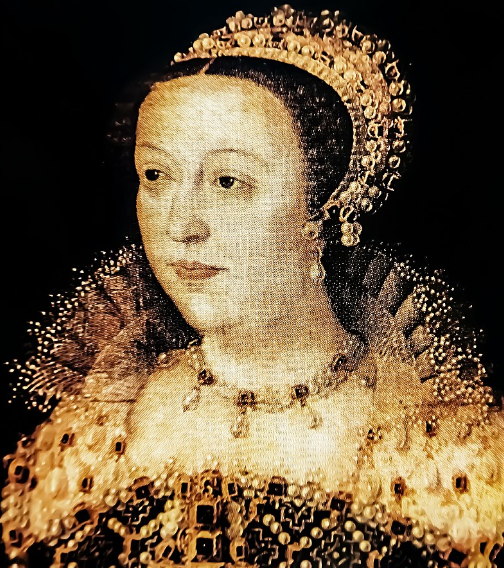
From Court Intrigues to Bedroom Affairs: Catherine de’ Medici’s Dual Legacy of Power and Seduction

In the annals of history, Catherine de’ Medici stands as a formidable figure, revered for her cunning intellect, political acumen, and unwavering determination. Born into the influential Medici family of Florence in 1519, Catherine was thrust into the world of power and intrigue from a young age. However, it was her marriage to Henry II of France that catapulted her into the heart of European politics and secured her place as one of history’s most dominant women.
Early Life and Background
Catherine’s early years were marked by tragedy and upheaval. Orphaned at a young age, she was raised in the shadow of the Italian Renaissance, surrounded by artists, scholars, and statesmen. It was here that she honed her skills in diplomacy and governance, laying the groundwork for her future as a formidable leader.
Marriage and Ascension to French Royalty
In 1533, Catherine’s life took a dramatic turn when she married Henry, the future king of France. Despite facing initial hostility from the French court due to her foreign origins, Catherine quickly proved herself to be a shrewd and capable queen consort. With her husband’s ascension to the throne in 1547, Catherine assumed an increasingly prominent role in French politics, wielding her influence behind the scenes to navigate the treacherous waters of court intrigue.
Regency and Rule
However, it was in the aftermath of Henry’s death in 1559 that Catherine truly came into her own as a political powerhouse. With her eldest son, Francis II, ascending to the throne at the tender age of 15, Catherine assumed the role of regent, effectively ruling France in his stead. Over the course of her regency, Catherine faced numerous challenges, including religious strife, foreign invasion, and internal rebellion. Yet through sheer force of will and cunning strategy, she managed to maintain stability and preserve the integrity of the French monarchy.
The St. Bartholomew’s Day Massacre
One of Catherine’s most enduring legacies is her role in the infamous St. Bartholomew’s Day Massacre of 1572. In response to growing tensions between Catholics and Protestants in France, Catherine orchestrated a brutal crackdown on the Protestant Huguenots, resulting in the deaths of thousands. While the massacre remains a dark stain on Catherine’s legacy, it also serves as a testament to her willingness to take decisive action in defense of her realm.
Legacy and Impact
Despite her controversial methods, Catherine’s reign saw significant advancements in art, culture, and governance. A patron of the arts, she supported the work of renowned artists such as Leonardo da Vinci and Michelangelo, and oversaw the construction of iconic landmarks such as the Tuileries Palace and the Château de Chenonceau. Moreover, her adept handling of foreign affairs ensured that France remained a dominant player on the European stage.
Feminine Dominance
While history often celebrates Catherine de’ Medici as a political powerhouse and influential ruler, her private life remains shrouded in mystery and intrigue. Beyond her illustrious political career, Catherine’s sexual activities, femdom tendencies, and rumored affairs have captivated historians and scholars for centuries. In this article, we delve into the tantalizing world of Catherine’s intimate relationships, shedding light on the enigmatic aspects of her sexual identity.
The Seductive Power of Catherine
Catherine’s allure extended far beyond the realm of politics, as evidenced by her reputation as a seductress and femme fatale. Blessed with beauty, charm, and an irresistible charisma, Catherine wielded her feminine wiles with masterful precision, captivating the hearts and minds of men and women alike. Whether orchestrating elaborate court intrigues or engaging in clandestine affairs, Catherine exuded an aura of sexual magnetism that left a lasting impression on all who encountered her.
Femdom Tendencies and Dominant Desires
Amidst the complexities of her political career, Catherine’s sexual proclivities and femdom tendencies have sparked much speculation and debate among historians. While concrete evidence is scarce, rumors abound of Catherine’s penchant for dominance and control in the bedroom. Some accounts suggest that she engaged in BDSM practices, including bondage, discipline, and sadomasochism, exerting her authority over submissive partners with ruthless efficiency. These rumors paint a portrait of Catherine as a formidable dominatrix, unafraid to explore the darker realms of human desire.
Affairs of the Heart:
Throughout her life, Catherine’s romantic entanglements and extramarital affairs were the subject of intense scrutiny and gossip within the French court. While her marriage to Henry II of France was ostensibly a political alliance, Catherine’s relationships with other men, including courtiers and advisors, often transcended the boundaries of duty and decorum. From clandestine rendezvous in hidden chambers to passionate trysts under the cover of darkness, Catherine’s romantic liaisons were as clandestine as they were captivating, fueling speculation and intrigue among her contemporaries.
The Legacy of Catherine’s Sexuality:
Despite the veil of secrecy that shrouds Catherine’s sexual life, her legacy as a Femdom icon endures to this day. From her rumored affairs with powerful men to her reputed femdom tendencies, Catherine’s intimate relationships continue to fascinate and inspire artists, writers, and historians alike. Whether viewed through the lens of scandal or admiration, Catherine’s sexual identity remains an indelible aspect of her complex persona, forever immortalized in the annals of history.
Conclusion: In conclusion, Catherine de’ Medici was a woman ahead of her time, whose indomitable spirit and fierce determination shaped the course of history. From her humble beginnings in Renaissance Italy to her reign as the de facto ruler of France, Catherine’s legacy endures as a testament to the enduring power of women in positions of leadership. Though her methods may have been controversial, there can be no denying the lasting impact of her rule on the fabric of European society. Catherine de’ Medici may have been a queen in name, but in truth, she was so much more. As we continue to unravel the mysteries of her life and legacy, one thing remains clear: Catherine de’ Medici was far more than a political ruler; she was a woman of passion, desire, and boundless complexity.
TEST YOUR SUB!
Does your submissive know the facts when it comes to powerful women in history? Put him in his place if he misses any of these questions:
- What year was Catherine de’ Medici born, marking the beginning of her journey into the world of power and intrigue?
- Answer: 1519
- Catherine’s prominent role in French politics reached new heights after the death of her husband, Henry II. In what year did she assume the role of regent, effectively ruling France in her son’s stead?
- Answer: 1559
- Catherine’s allure extended beyond politics, with rumors swirling about her sexual proclivities and femdom tendencies. What were some of the practices speculated to be part of her bedroom activities?
- Answer: BDSM practices, including bondage, discipline, and sadomasochism
- What was the name of the iconic landmark Catherine de’ Medici oversaw the construction of during her reign in France?
- Answer: The Tuileries Palace
- Despite her controversial methods, Catherine de’ Medici is credited with significant advancements in which three areas?
- Answer: Art, culture, and governance






















































Latest Comments